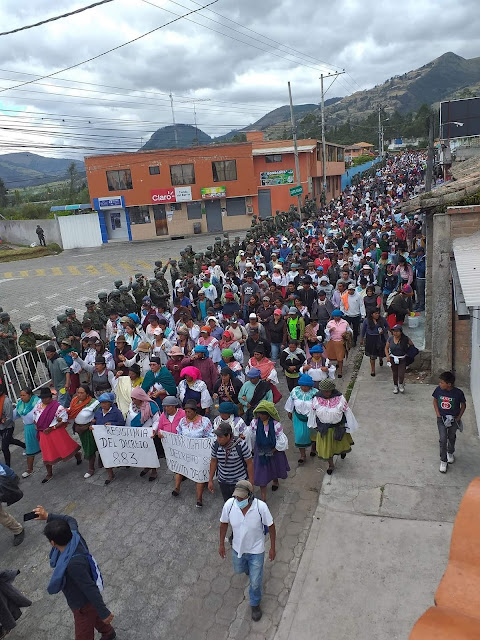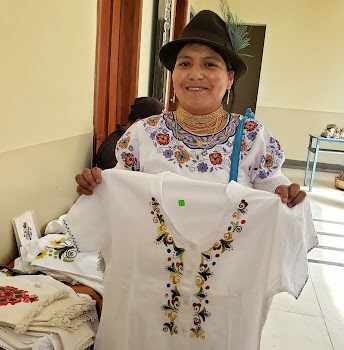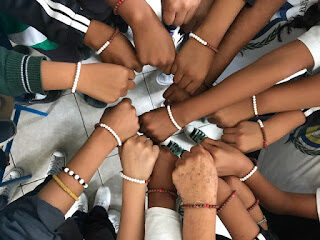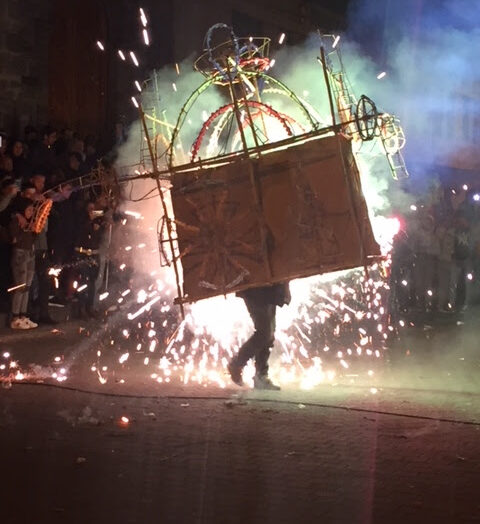If you haven’t been keeping up on your world news, or watching my Facebook posts, Ecuador is experiencing some volatile political protests. It’s amazing, scary, confusing, and sad all at the same time, but overall, an incredibly interesting time to be here. In this post, I will try to explain the causes of the protests and what is currently happening, but clearly there is a lot of misleading news being published, and since I’m safe in my Ecuadorian home, I really don’t understand all of what’s going on myself. Also, it seems things are changing every minute. Go to onthewingadventures.blogspot.com to read my full story with complete news videos.
On Wednesday, October 2nd, Ecuadorian President Lenin Moreno announced new economic reforms to the country that included lowering the salary of public contractors by 20%, reducing the vacation days of public sector employees from 30 days annually to only 15 days, and requiring employees of the state to work for free one day per month as their gift to the well-being of the country. You can imagine that these reforms, effective immediately, would not go over well in any country, but the reform that has caused the most controversy was the elimination of fuel subsidies that have been in effect for four decades. This means that a gallon of gasoline that last week cost approximately $1.85, now costs $2.30. And a gallon of diesel, which is what most trucks and buses use in this country, went from approximately $1.08 to $2.27. This is a 120% increase at the gas pumps overnight. For a poor country whose majority of its population depend upon public transportation daily, this is a huge hit to their pocket.
And so, a “National Paro”, or strike, began. Instantly, bus drivers and taxi drivers parked their vehicles and took to the streets to protest. And they didn’t just march, they blocked the main artery through Ecuador, the PanAmerican Highway, and most major streets in each city along the way. They used burning tires, whole trees, dumptruck loads of debris, garbage and of course their buses to block the roads and force the country to a halt. Instantly all classes were cancelled (because students can’t get to school), and many stores were forced to close either because their inventory ran out, or they supported (or were forced to support) the strike. After two days of serious disruption, the transportation unions felt like they had been heard by the government, and they called off the strike. This is when the Indigenous stepped in. The Confederation of Indigenous Nationalities of Ecuador (CONAIE) essentially said, “No. Viva el Paro!”, or “The Strike Continues!”
In Ecuador, we have the Mestizos, which are people of Spanish / Indigenous descent, the Afro-Ecuadorians which are descendants of slaves and then the full Indigenous who are the original native Americans of Ecuador. There are approximately 17.2 million people in Ecuador, and 1.1 million of them claim an Indigenous heritage. As of 1998, Ecuador is one of the first countries to give their Indigenous equal rights in their Constitution, a place in the government and autonomy for their own villages and laws. Although many Indigenous do live in cities, the vast majority live in the mountains and the Amazon Basin and are the primary producers of all the food in this country. Therefore, they tend to be “the poor farmers”. That said, the Indigenous are very well organized and very politically savvy. There are 14 different Indigenous groups that make up the Confederation of Indigenous Nationalities of Ecuador (CONAIE) and when they unite behind a common cause, they historically make it happen. In other words, they have a lot of power, and they wield it very wisely. It’s important to know, they are the ones who have ousted three former presidents in recent memory.
So, why are they fighting now?
In this poor country, it’s the Indigenous that depend primarily on the buses to take their products to the markets. The bus companies have already announced a minimum $0.10 fare increase to offset the fuel costs, and subsequently prices for food in the markets will increase, to counter the extra transportation costs. The thought is that the farmers will have to raise their prices too, and then less people will be able to afford their products. So, if they’re going to pay more for their transport, and more for the gasoline of their trucks, and earn less for their products, they are the ones shouldering more of these debts; more so than the weathier, car-owning Mestizos who live in the city.
This is a good quick-read summary of why Ecuadorians are fighting these new economic measures:
https://www.aljazeera.com/news/2019/10/ecuador-indigenous-groups-workers-fuel-protests-191005164804478.html?fbclid=IwAR3CTV1EKjeyalMMFW3_4o-oR-tVVxsALBbNYjl_AfAFSn-DOSse7fFvGzA
Furthermore, while the former president, Rafael Correa, modernized the country and stabilized its economy with very liberal policies, he did get the country into massive foreign debt and he auctioned off Ecuador’s natural resources to try to pay some of it off. Because of this, many other countries now have their hands in Ecuador’s vast petroleum reserves in the Amazon Rainforest and precious minerals in the mountains, at a huge cost to the environment and the livelihoods of the Indigenous that live on that land. Now, the current president, whose new policies are more neoliberal than the platform he ran on, says he needs to borrow $4.2 billion from the IMF, or the International Monetary Fund, to further pay off these debts. But this loan from the IMF is contingent on maximizing output of petroleum resources (conveniently to the IMF countries) and reducing the national budget. This last part might sound reasonable, but Ecuador is already an impoverished country. And many people in Ecuador are skeptical of the power and long-term effects of having dealings with the IMF.
So, by the weekend, the Indigenous were congregating in their villages, planning their attack, and it was decided that they would continue to disrupt all major roads and transportation options throughout the country, while thousands more planned to make their way to Quito by Wednesday, October 9th for a national march on the capitol. And come they did. All day Monday and Tuesday, live-feed videos showed thousands of Indigenous men, women and children walking and riding on the back of pick-ups all the way to Quito. They came from hundreds of miles away to make their voices heard. They were joined by transportation workers, public employees and students. By Tuesday, it was estimated that more than 20,000 protestors were nearing Quito, and so President Lenin Moreno decided to officially move the government to Ecuador’s largest city, Guayaquil, on the coast. Upon hearing this, thousands of Indigenous turned their trucks around and headed there instead. I’ve never witnessed a mass migration of people such as this. I was so moved by the power of the people and their passion to be involved in the politics and well-being of this country.
Here is a video that exemplifies the thousands of protestors on the move toward Quito:
https://www.facebook.com/conaie.org/videos/1361872477297160?sfns=mo
Here is a video of protestors arriving in Quito. This is only protestors from one village in the north. They came from hundreds of villages, walking and riding for days.
https://www.facebook.com/conaie.org/videos/1140877119449830?sfns=mo
I hear the word “bravo” a lot when referring to the Indigenous here in Ecuador. It means “fierce”. They don’t have backpacks of food, clothes, or blankets. They don’t worry about being too old for the journey. They don’t leave their kids at home with someone else. When they hear the call around the countryside to mobilize, they start walking in the clothes they are wearing. Their kids are at their side or strapped to their back. They tend to their needs as necessary along their journey. They exemplify the ideal that “together, nothing is impossible in Ecuador”. Bravo, indeed.
Here is a propaganda video sent out by CONAIE to promote their strike and their strength:
Title: National Mobilization, Ecuador 2019
https://www.facebook.com/conaie.org/videos/512832692875486?sfns=mo
The text outlines the basics of their platform:
-For the defense of our territories,
-Down with the neoliberal (Government) proposals,
-Out with the FMI (International Monetary Fund- IMF),
-Down with the mines
-Territories free from extractions
-Strong Companions
And so, by Tuesday afternoon, a mass had arrived in Quito and the protesting began through the streets and into the National Asamblea or Legislative Buildings:
https://www.facebook.com/conaie.org/videos/2463674747224987?sfns=mo
https://www.facebook.com/conaie.org/videos/550033472493828?sfns=mo
I see a lot of support on Facebook for the efforts of the protestors and local people from Quito turned out in droves to donate blankets, food and medicine. Large parks and stadiums were opened for them to sleep and medical students have been providing free medical care and first-aid on the front-lines. The Red Cross is extremely well-trained and organized in Ecuador and they are on the front-lines as well. I also have seen many photos and heard of examples where protestors and police were being mutually respectful of one another, and sharing food together. There is a strong belief that “Somos Ecuatorianos”; we are all Ecuadorians trying to do what’s best for our country.
But unfortunately, when you have massive people in the streets fighting for their rights, there’s going to be some problems. Overwhelmingly, the Indigenous people are protesting in a peaceful manner, but others have taken to the streets to destroy public property and loot for their benefit. And so the police and military have had a very difficult time controlling the situation on the ground, which has led to some police brutality, a mandatory nightly curfew, and a two-month State of Emergency.
Elsewhere, the Indigenous fighters and protestors have taken over some oil drills in the Amazon and have shut down drilling operations. They’ve captured military tanks and set them on fire. They’ve overpowered water treatment facilities and hydro-electric plants, and have cut off water supplies to some cities. They have justified all of this because these facilities are on their Indigenous land.
Here is a video of some street fighting in the Historic Center of Quito:
https://www.facebook.com/conaie.org/videos/2431410080227748?sfns=mo
Wednesday night, things got really complicated when the police started to tear-gas buildings in Quito that were considered safe havens and rest areas for the protestors. The Indigenous, who are not used to injustices going unpunished, have taken some police hostage and today, publicly beat an officer in accordance with their Indigenous law.
Earlier in the week, the Indigenous organization claimed they will keep up protests until the fuel subsidies are re-enacted; but now, because Moreno and his military police have reacted by violently repressing the protests, the Indigenous feel that things have gone too far. Now, they say they won’t stop until President Moreno is ousted from his position and the deal with the IMF is nullified. In a statement today, CONAIE reiterated that: “This fight is not for today, it is not only for the price of gasoline, it is to avoid a mortgage on our future, one that we will have to pay with hunger and poverty for two or three generations if we don’t stop it today.” They have repeatedly offered suggestions that Ecuador’s government can cut their budget in other ways, namely by reducing legislative salaries and excessive government spending, as well as eliminating corruption and the multiple layers of government. President Lenin Moreno says that he’s willing to discuss his new economic policies with the Indigenous leaders, but that he will not change his mind in dealing with the IMF, nor will he step down. He has also accused them of conspiring to destabilize the government with the former President Rafael Correa – who’s still popular in this country despite the fact that he’s living in asylum in Brussels for charges of corruption and kidnapping. (I’m not making this stuff up!)
Today, we learned that a leader of the Indigenous Party was killed during the protests yesterday, along with seven other fighters. And CONAIE has called for another wave of Indigenous fighters to travel to Quito this weekend from the Amazon Basin. From what I understand, the Indigenous from the Amazon take “bravo” to a whole new level.
Here is a video of Amazonian Indigenous at a rally in their community:
https://www.facebook.com/conaie.org/videos/769927426776648?sfns=mo
Tomorrow is Day 9 of the National Paro and the tension continues in Quito and in every small town throughout the country. Here is a video of a confrontation that happened about 15 minutes from my house. Luckily, I slept through the whole thing:
https://www.facebook.com/366634003370910/posts/2660922993941988?sfns=mo
As for me, I’m safe at home. The Peace Corps takes our safety and security extremely seriously. We have been mandated to stay in our communities and strongly advised to stay inside. We receive daily updates on the situation, and are checked upon regularly by calls from Peace Corps staff. It is true, that if this National Strike lasts for too many more days, food and cooking gas shortages could become a problem. Since food trucks can’t get through via the highways, shelves are already empty in the largest stores. Some communities are also experiencing water shortages as the Indigenous have cut off supplies from the mountain reservoirs in order to further pressure the government. Peace Corps Volunteers who live in the cities are obviously the most vulnerable to all of these problems. But, I essentially live in the country and am part of a big family who own farms of their own, and have lots of friends and neighbors who will all help each other out. So far, we have water, we have electricity and eggs, milk and beans are easy to get. I’m doing just fine. Since there’s no school, and no plans to open school again soon, I spend my days taking walks in the countryside, studying Spanish, writing, cooking with Margarita, playing with my little brother Pablo and constantly checking the live protest feeds on Facebook. It’s a very interesting time to be here.
That said, the volunteers in Quito have already been consolidated in one safe place. If this doesn’t end peacefully, and soon, I might have to leave my family too, to go to another safe haven. Let’s hope it doesn’t come to that.







Cooper Zale
I had no idea about this… thanks for the report… i will try to stay informed!